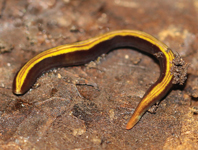Abstract
The Neotropical foam-nesting genus Leptodactylus Fitzinger is currently composed of 75 species (Frost 2019) divided into four monophyletic species groups (De Sá et al. 2014). The L. melanonotus species group includes 17 species delimited by five adult osteological character-states (De Sá et al. 2014). Leptodactylus natalensis Lutz is the only species of the L. melanonotus species group that occurs in north of the Brazilian Atlantic Rain Forest (De Sá et al. 2014; Almeida et al. 2016) and whose type locality is the municipality of Natal, state of Rio Grande do Norte, Brazil (Lutz 1930). The tadpole of this species was briefly described by Oliveira & Lírio-Júnior (2000) based on a single individual from the municipality of Aracaju, state of Sergipe, Brazil. Herein, we present a complete redescription of the tadpole of this species, including morphometric data and interpopulational variation. Besides, we provide comparisons with all members of the L. melanonotus group.
References
Almeida, J.P.F.A., do Nascimento, F.A.C., Torquato, S., Lisboa, B.S., Tiburcio, I.C.S., Palmeira, C.N.S., Lima, M.G. & Mott, T. (2016) Amphibians of Alagoas State, northeastern Brazil. Herpetology Notes, 9, 123–140.
Altig, R. & Johnston, G.F. (1989) Guilds of anuran larvae: relationships among developmental modes, morphologies, and habits. Herpetological Monographs, 3, 81–109.
https://doi.org/10.2307/1466987
Altig, R. & McDiarmid, R.W. (1999) Body plan: development and morphology. In: McDiarmid, R.W. & Altig, R. (Eds.), Tadpoles: The Biology of Anuran Larvae. The University of Chicago Press, Chicago, pp. 24–51.
De Sá, R.O., Reuber, R. & Guimarães, L.D. (2007) Description of the tadpole of Leptodactylus pustulatus Peters, 1870 (Anura: Leptodactylidae). Zootaxa, 1523 (1), 49–58.
https://doi.org/10.11646/zootaxa.1523.1.2
De Sá, R.O., Grant, T., Camargo, A., Heyer, W.R., Ponssa, M.L. & Stanley, E. (2014) Systematics of the neotropical genus Leptodactylus Fitzinger, 1826 (Anura: Leptodactylidae): phylogeny, the relevance of non-molecular evidence, and species accounts. South American Journal of Herpetology, 8, 1–128.
https://doi.org/10.2994/SAJH-D-13-00022.1
Duellman, W.E. (1978) The biology of an equatorial herpetofauna in Amazonian Ecuador. Miscellaneous Publication of the Museum of Natural History, University of Kansas, 65, 1–352.
Frost, D.R. (2019) Amphibian species of the world: an online reference. Version 6.0. American Museum of Natural History, New York. Electronic Database accessible. Available from: http://research.amnh.org/herpetology/amphibia/index.html (accessed 10 December 2019)
Gosner, K.L. (1960) A simplified table for staging anuran embryos and larvae with notes on identification. Herpetologica, 16, 183–190.
Grosjean, S. (2005) The choice of external morphological characters and developmental stages for tadpole–based anuran taxonomy: a case study in Rana (Sylvirana) nigrovittata (Blyth, 1855) (Amphibia, Anura, Ranidae). Contributions to Zoology, 74, 61–76.
https://doi.org/10.1163/18759866-0740102005
Heyer, W.R. (1970). Studies on the frogs of the genus Leptodactylus (Amphibia: Leptodactylidae). 6. Biosystematics of the melanonotus group. Contributions in Science. Natural History Museum of Los Angeles County, 191, 1–48.
Heyer, W.R. (1994) Variation within the Leptodactylus podicipinus-wagneri complex of frogs (Amphibia: Leptodactylidae). Smithsonian Contributions to Zoology, 546, 1–124.
https://doi.org/10.5479/si.00810282.546.i
Lima, A.P. (1992) The tadpole of Leptodactylus riveroi Heyer and Pyburn, 1983 (Anura: Leptodactylidae). Journal of Herpetology, 26, 91–93.
https://doi.org/10.2307/1565032
Lutz, A. (1930) Segunda memoria sobre especies brasileiras do genero Leptodactylus, incluindo outras aliadas. Memórias do Instituto Oswaldo Cruz, 23, 1–34.
https://doi.org/10.1590/S0074-02761930000100001
Lyra, M.L., Haddad, C.F. & de Azeredo‐Espin, A.M.L. (2017) Meeting the challenge of DNA barcoding Neotropical amphibians: polymerase chain reaction optimization and new COI primers. Molecular Ecology Resources, 17, 966–980.
https://doi.org/10.1111/1755-0998.12648
Oliveira, F.F. & Lírio-Júnior, G.P. (2000). Anfíbios anuros do campus da Universidade Federal de Sergipe. Biologia Geral e Experimental, 1, 42–74.
Pinheiro, P.D.P., Pezzuti, T.L. & Garcia, P.C.D.A. (2012) The tadpole and vocalizations of Hypsiboas polytaenius (Cope, 1870) (Anura, Hylidae, Hylinae). South American Journal of Herpetology, 7, 123–133.
https://doi.org/10.2994/057.007.0202
Savage, J.M. (2002) The amphibians and reptiles of Costa Rica. University of Chicago Press, Chicago, 934 pp.
Schulze, A., Jansen, M. & Köhler, G. (2015) Tadpole diversity of Bolivia’s lowland anuran communities: molecular identification, morphological characterisation, and ecological assignment. Zootaxa, 4016 (1), 1–111.
https://doi.org/10.11646/zootaxa.4016.1.1
Vences, M., Thomas, M., Bonett, R.M. & Vieites, D.R. (2005) Deciphering amphibian diversity through DNA barcoding: chances and challenges. Philosophical Transactions of the Royal Society B: Biological Sciences, 360, 1859–1868.
https://doi.org/10.1098/rstb.2005.1717

